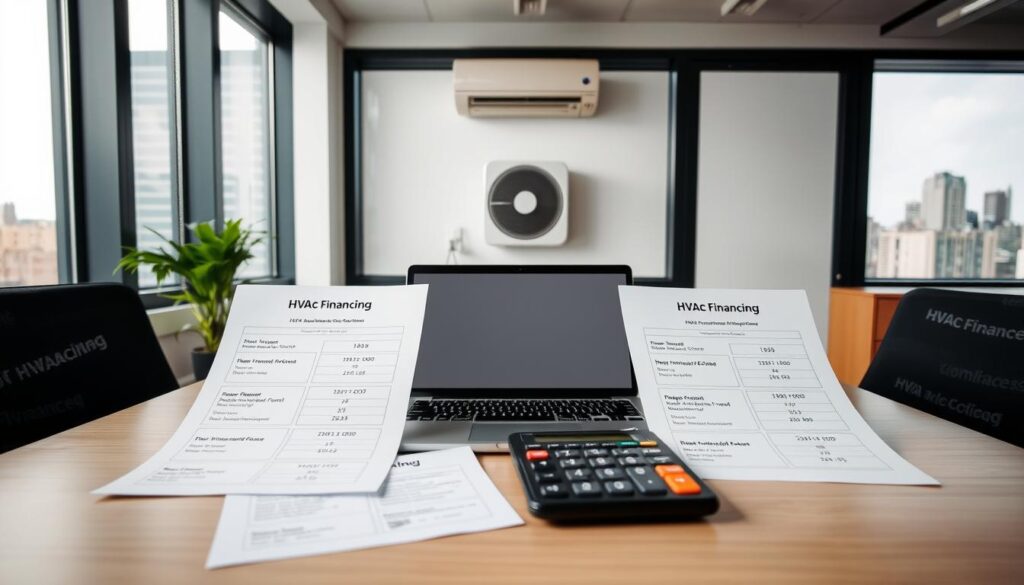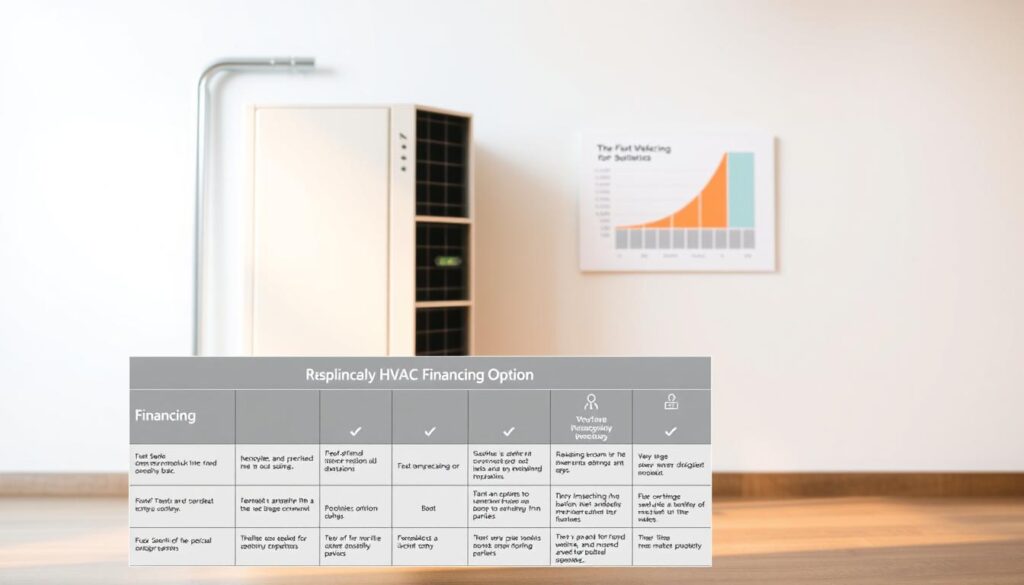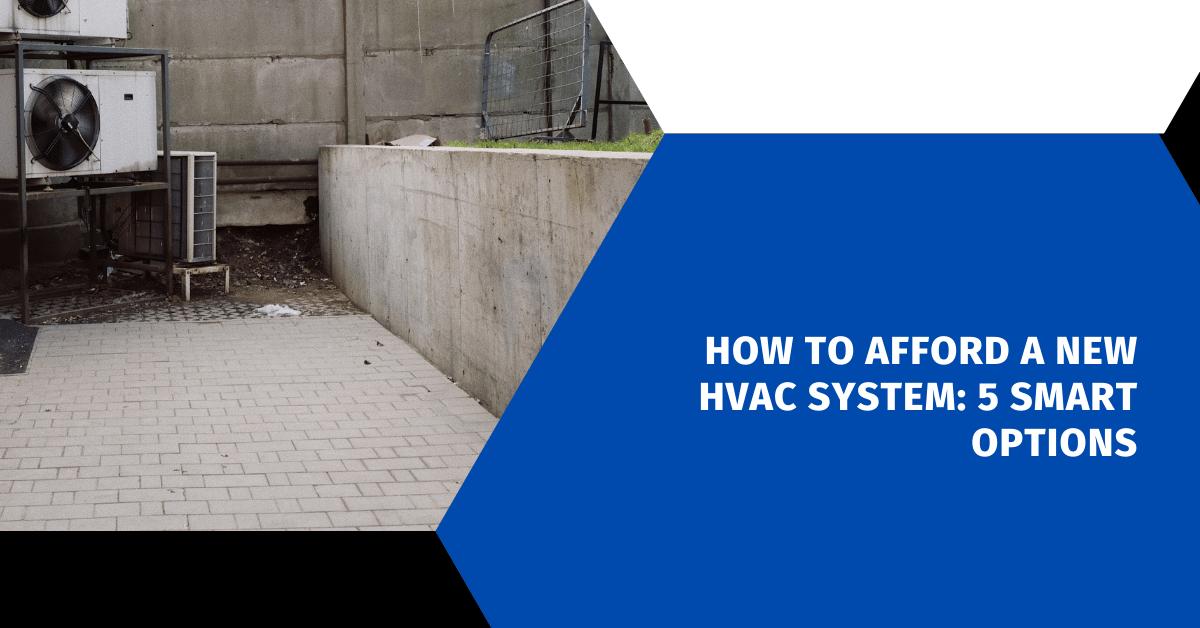Affiliate Disclosure
HVAC Guide Guys is a participant in the Amazon Services LLC Associates Program, an affiliate advertising program designed to provide a means for sites to earn advertising fees by advertising and linking to Amazon.
How to Afford a New HVAC System? Are you worried about the cost of a new heating and cooling system? There are affordable ways to upgrade your HVAC without spending too much.

Getting a new HVAC system can seem daunting. These systems are a big investment, costing between $6,000 and $20,000. But, there are ways to make this expense more manageable.
Knowing your options for affordable HVAC systems can make this big expense easier. There are smart financing strategies that can help you improve your home’s comfort without emptying your wallet.
Key Takeaways
- HVAC replacement costs vary widely based on system type
- Multiple financing options are available for homeowners
- Energy-efficient systems can reduce long-term expenses
- Tax credits and rebates can offset installation costs
- Professional consultation can help identify the best financing strategy
Table of Contents
Understanding HVAC System Costs and Components
Figuring out the cost of a new furnace can be tough. Your HVAC system has many parts working together to keep your home comfy. Knowing these parts helps you choose the right heating and cooling options.
It’s important to know the basic parts of your HVAC system when looking at financing options. Let’s look at the main parts that affect your system’s performance and cost.
Essential HVAC System Components
- Outdoor condensing unit
- Indoor air handler
- Ductwork system
- Thermostat
- Refrigerant lines
Pricing Factors to Consider
Several things affect the cost of a new furnace:
- Home size and layout
- System efficiency ratings
- Brand reputation
- Installation complexity
- Local climate conditions
Average Cost Ranges by System Type
| System Type | Cost Range | Typical Coverage |
|---|---|---|
| Split System (AC + Furnace) | $6,000 – $20,000 | 1,500-2,500 sq ft |
| Heat Pump System | $7,000 – $22,000 | 1,800-3,000 sq ft |
| Ductless Mini-Split | $3,000 – $15,000 | 500-2,000 sq ft |
Your financing options will depend on these system details. Think about your home’s needs to find the best value.
Why You Might Need a New HVAC System
Knowing when to replace your air conditioning can save you a lot of money and stress. Your HVAC system has a limited lifespan. Spotting the signs early helps you budget for a new one before it breaks down.
Age is key in deciding if you need a new system. Most HVAC units last 10-15 years. If yours is getting close to or has passed this age, it’s time to think about replacing it.
- Frequent repairs costing more than 50% of a new system’s price
- Inconsistent room temperatures
- Rising energy bills indicating reduced efficiency
- Strange noises or unusual odors from your HVAC unit
Energy efficiency is also important. Older systems use more electricity, which means higher bills. A new, efficient HVAC system can cut your energy costs by 20-30%.
| System Age | Replacement Likelihood | Potential Cost Savings |
|---|---|---|
| 0-5 years | Low | Minimal |
| 6-10 years | Medium | 10-15% |
| 11-15 years | High | 20-30% |
| 15+ years | Critical | 30-50% |
By keeping an eye on your HVAC system, you can plan a cost-effective replacement. This way, you avoid unexpected costs and keep your home comfortable and energy-efficient.
Explore Our HVAC Shop
Looking for top-rated HVAC tools, parts, and accessories? Visit our shop and find the perfect solution for your needs.
Visit the ShopHow to Afford a New HVAC System
Getting a new HVAC system is a big deal for homeowners. Luckily, there are many ways to pay for it without spending too much. Home improvement loans for HVAC can help you manage costs.
Looking into different payment plans can make getting a new HVAC system easier. It can also fit better into your budget. Let’s explore the best ways to finance your home comfort.
HVAC Company Payment Plans
Many HVAC companies have payment plans to help you out. These plans include:
- Zero-interest promotional periods
- Low monthly payment options
- Deferred interest arrangements
Personal Loan Options
Personal loans are a great choice for HVAC installation. Banks and online lenders offer good rates. They come with benefits like:
- Quick approval process
- Fixed interest rates
- Predictable monthly payments
Home Equity Solutions
If you have a lot of equity, you can use it to finance HVAC upgrades. Home equity loans and lines of credit offer:
| Option | Interest Rates | Loan Term |
|---|---|---|
| Home Equity Loan | Lower fixed rates | 5-15 years |
| Home Equity Line of Credit | Variable rates | Flexible drawing period |
“The right financing can turn your HVAC dream into an affordable reality.” – HVAC Financing Expert
Pro tip: Compare multiple financing options and choose the one that best fits your financial situation and long-term budget goals.
Energy Efficient Systems and Long-term Savings
Getting an energy efficient hvac tax credit can change your home’s comfort and finances. Today’s heating and cooling systems can cut your monthly bills. They keep your home at the perfect temperature.
When looking at affordable heating and cooling, knowing their efficiency is key. The Seasonal Energy Efficiency Ratio (SEER) rating shows how much energy you’ll save. A higher SEER means you use less energy and pay less for utilities.
- High-efficiency systems can cut cooling costs by 20-40%
- Reduced energy consumption means lower monthly bills
- Improved home comfort with consistent temperature control
Buying an energy-efficient HVAC system might seem expensive at first. But the long-term savings can make up for the cost. These systems offer:
- Significant energy savings
- Enhanced home value
- Reduced carbon footprint
The U.S. Department of Energy suggests getting systems with SEER ratings of 15 or higher. These systems use less energy and might get you tax credits or rebates.
“Investing in energy efficiency is investing in your home’s future” – Energy Star Guidelines
Available Rebates and Tax Incentives
Getting a new HVAC system can be pricey. But, many hvac rebates and energy efficient hvac tax credits can cut down your costs. Knowing about these incentives can help you choose wisely for your home’s comfort and energy use.
Homeowners can save a lot by upgrading their heating and cooling systems. Here are the main ways to save money:
Federal Tax Credits for Energy-Efficient Systems
The federal government gives big tax credits for making your home more energy-efficient. Right now, you can get:
- Up to $2,000 tax credit for qualifying heat pumps
- 30% tax credit for qualified biomass stoves
- Credits for high-efficiency central air conditioners
State and Local Incentives
Many states also offer extra money for energy-efficient HVAC upgrades. These offers change by place and might include:
- Direct rebates for system installations
- Property tax exemptions
- Low-interest financing options
Utility Company Programs
Local utility companies often give great rebates for energy-efficient HVAC systems. These deals can offer:
- Rebates from $300 to $1,200
- Discounts on energy-efficient equipment
- Free energy audits
Pro tip: Always check with your local utility provider and state energy office to maximize your potential savings.
Explore Our HVAC Shop
Looking for top-rated HVAC tools, parts, and accessories? Visit our shop and find the perfect solution for your needs.
Visit the ShopChoosing the Right HVAC Financing Option

Choosing the right hvac financing is important. It depends on your financial situation. When looking to buy a new hvac system, consider several key factors.
Your credit score is crucial. Homeowners with good credit get better rates and terms.
- Assess your current monthly budget
- Review your credit score
- Consider long-term home ownership plans
- Balance short-term affordability with potential energy savings
There are different ways to finance your hvac system. Let’s look at the most common ones:
| Financing Option | Credit Requirements | Interest Rates | Typical Term Length |
|---|---|---|---|
| HVAC Company Financing | Moderate | 6-12% | 1-5 years |
| Personal Loans | Good to Excellent | 4-15% | 2-7 years |
| Home Equity Loans | Excellent | 3-8% | 5-15 years |
Pro tip: Always read the fine print and understand all terms before committing to any financing agreement. Compare multiple offers to find the best one for you.
Remember, the best hvac financing option aligns with your budget, credit profile, and long-term home comfort goals.
Smart Ways to Reduce HVAC Installation Costs
It’s not hard to save on heating and cooling systems. With some planning, you can cut down on costs. This way, you can get a good deal on your air conditioning replacement.
When it comes to HVAC costs, timing is everything. Smart homeowners know when to save money.
Seasonal Timing Advantages
Installing your HVAC system at the right time can save you a lot. Here are some tips:
- Install during off-peak seasons (spring or fall)
- Avoid peak summer and winter months
- Contractors often offer lower rates during slower periods
Bundle Deals and Promotions
To save money, you need to buy smart. Here are some ways to cut costs:
| Savings Strategy | Potential Cost Reduction |
|---|---|
| Simultaneous heating and cooling system replacement | Up to 20% total system cost savings |
| Seasonal promotional discounts | 10-15% off installation |
| Multiple system package deals | Significant bulk purchase discounts |
Pro tip: Always request multiple quotes and negotiate with contractors. Many companies are willing to work with you to find a budget-friendly air conditioning replacement that meets your financial needs.
Smart homeowners plan ahead and look for opportunities to reduce HVAC installation costs.
Explore Our HVAC Shop
Looking for top-rated HVAC tools, parts, and accessories? Visit our shop and find the perfect solution for your needs.
Visit the ShopWorking with HVAC Contractors and Payment Terms

Dealing with hvac payment plans can be tough when you need a new HVAC system. Knowing how to work with contractors can help you get the best deal for your home’s comfort.
Talking about your HVAC system installation is crucial. Contractors have different payment options to help you out. Before you sign anything, ask about the financing details.
- Request a detailed written estimate
- Ask about any extra costs
- Find out about payment plans
- Check the financing terms closely
Your negotiation should be clear and open. Good HVAC contractors will explain costs and payment plans clearly.
| Payment Option | Key Features | Typical Terms |
|---|---|---|
| Installment Plans | Spread cost over time | 3-12 month terms |
| Zero-Interest Financing | No extra cost if paid within promo period | 6-24 month periods |
| Manufacturer Financing | Direct equipment manufacturer plans | Competitive rates |
Pro tip: Always read the fine print and ask about prepayment penalties or hidden fees when exploring hvac payment plans.
Choosing the right contractor is more than just the price. Look for ones with flexible financing, clear prices, and good warranties. This ensures your home’s comfort system is a smart investment.
Maintaining Your Investment After Purchase
Keeping your new heating and cooling systems in good shape is key. It starts with smart maintenance to make your investment last longer. Regular care stops expensive breakdowns and keeps your systems running smoothly.
To keep your HVAC system in top shape, follow these important steps:
- Replace air filters every 90 days
- Schedule professional annual inspections
- Clean air vents and registers monthly
- Check refrigerant levels
- Inspect ductwork for potential leaks
Regular maintenance brings big benefits. Experts say well-maintained systems can last up to 15-20 years, compared to 10-12 years for neglected ones. This saves money and keeps your system running well for years.
Your HVAC system is a big investment. Regular care saves money, cuts energy use, and lowers repair costs. A little effort now means big savings later.
“An ounce of prevention is worth a pound of cure” – especially true for HVAC systems.
Professional maintenance is more than fixing problems. It’s about stopping them before they start. Work with certified HVAC technicians for thorough checks and to catch issues early.
Explore Our HVAC Shop
Looking for top-rated HVAC tools, parts, and accessories? Visit our shop and find the perfect solution for your needs.
Visit the ShopUnderstanding Warranty Coverage and Protection Plans
Investing in a new HVAC system means you need to know about warranties. Warranties can affect the cost of installing a new furnace. They also give homeowners peace of mind.
Most HVAC systems have two main warranty types:
- Manufacturer’s Limited Warranty
- Extended Protection Plans
Manufacturer warranties usually last 5-10 years. They cover important parts like:
- Compressor
- Heat exchanger
- Major electrical components
| Warranty Type | Coverage Period | Typical Cost |
|---|---|---|
| Standard Manufacturer Warranty | 5-10 years | Included with purchase |
| Extended Protection Plan | 10-15 years | $300-$800 |
Extended protection plans offer more than standard warranties. They can cover labor costs and unexpected repairs. This can save you thousands over time.
Before buying, read the warranty details carefully. Look for specific conditions, what’s not covered, and what parts are protected. Some warranties need professional installation and regular maintenance to stay valid.
Protect your investment by understanding the full scope of your HVAC system’s warranty coverage.
Conclusion
Getting a new HVAC system doesn’t have to be hard. There are many ways to finance it, so you can find something that works for you. It’s all about knowing your options and planning well.
There are many ways to pay for a new HVAC system. You can get personal loans or use incentives from utility companies. It’s important to think about what you can afford now and what will save you money in the long run.
A good HVAC system is more than just a cost. It makes your home comfortable and can even save you money on bills. Look into different financing options and talk to HVAC experts to choose wisely.
There’s a way to get the HVAC system you need without spending too much. Look at financing options, check out incentives, and focus on energy efficiency. This way, you can improve your home’s comfort without emptying your wallet.

